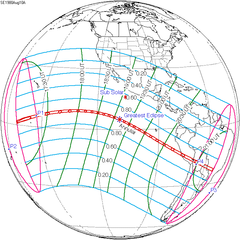|
August 1971 lunar eclipse
A total lunar eclipse occurred at the Moon’s ascending node of orbit on Friday, August 6, 1971,[1] with an umbral magnitude of 1.7283. It was a central lunar eclipse, in which part of the Moon passed through the center of the Earth's shadow. A lunar eclipse occurs when the Moon moves into the Earth's shadow, causing the Moon to be darkened. A total lunar eclipse occurs when the Moon's near side entirely passes into the Earth's umbral shadow. Unlike a solar eclipse, which can only be viewed from a relatively small area of the world, a lunar eclipse may be viewed from anywhere on the night side of Earth. A total lunar eclipse can last up to nearly two hours, while a total solar eclipse lasts only a few minutes at any given place, because the Moon's shadow is smaller. Occurring about 2.3 days before perigee (on August 9, 1971, at 2:00 UTC), the Moon's apparent diameter was larger.[2] VisibilityThe eclipse was completely visible over central and east Africa, much of Asia, western Australia, and Antarctica, seen rising over central and eastern South America, Europe, and west Africa and setting over east and northeast Asia and eastern Australia.[3]
Eclipse detailsShown below is a table displaying details about this particular solar eclipse. It describes various parameters pertaining to this eclipse.[4]
Eclipse seasonThis eclipse is part of an eclipse season, a period, roughly every six months, when eclipses occur. Only two (or occasionally three) eclipse seasons occur each year, and each season lasts about 35 days and repeats just short of six months (173 days) later; thus two full eclipse seasons always occur each year. Either two or three eclipses happen each eclipse season. In the sequence below, each eclipse is separated by a fortnight. The first and last eclipse in this sequence is separated by one synodic month.
Related eclipsesEclipses in 1971
Metonic
Tzolkinex
Half-Saros
Tritos
Lunar Saros 128
Inex
Triad
Lunar eclipses of 1969–1973This eclipse is a member of a semester series. An eclipse in a semester series of lunar eclipses repeats approximately every 177 days and 4 hours (a semester) at alternating nodes of the Moon's orbit.[5] The penumbral lunar eclipses on April 2, 1969 and September 25, 1969 occur in the previous lunar year eclipse set, and the lunar eclipses on June 15, 1973 (penumbral) and December 10, 1973 (partial) occur in the next lunar year eclipse set.
Saros 128This eclipse is a part of Saros series 128, repeating every 18 years, 11 days, and containing 71 events. The series started with a penumbral lunar eclipse on June 18, 1304. It contains partial eclipses from September 2, 1430 through May 11, 1827; total eclipses from May 21, 1845 through October 21, 2097; and a second set of partial eclipses from November 2, 2115 through May 17, 2440. The series ends at member 71 as a penumbral eclipse on August 2, 2566. The longest duration of totality was produced by member 37 at 100 minutes, 43 seconds on July 26, 1953. All eclipses in this series occur at the Moon’s ascending node of orbit.[6]
Eclipses are tabulated in three columns; every third eclipse in the same column is one exeligmos apart, so they all cast shadows over approximately the same parts of the Earth.
Tritos seriesThis eclipse is a part of a tritos cycle, repeating at alternating nodes every 135 synodic months (≈ 3986.63 days, or 11 years minus 1 month). Their appearance and longitude are irregular due to a lack of synchronization with the anomalistic month (period of perigee), but groupings of 3 tritos cycles (≈ 33 years minus 3 months) come close (≈ 434.044 anomalistic months), so eclipses are similar in these groupings.
Inex seriesThe inex series repeats eclipses 20 days short of 29 years, repeating on average every 10571.95 days. This period is equal to 358 lunations (synodic months) and 388.5 draconic months. Saros series increment by one on successive Inex events and repeat at alternate ascending and descending lunar nodes. This period is 383.6734 anomalistic months (the period of the Moon's elliptical orbital precession). Despite the average 0.05 time-of-day shift between subsequent events, the variation of the Moon in its elliptical orbit at each event causes the actual eclipse time to vary significantly. It is a part of Lunar Inex series 40. All events in this series shown (from 1000 to 2500) are central total lunar eclipses.
Half-Saros cycleA lunar eclipse will be preceded and followed by solar eclipses by 9 years and 5.5 days (a half saros).[8] This lunar eclipse is related to two annular solar eclipses of Solar Saros 135.
See alsoNotes
External links
|
||||||||||||||||||||||||||||||||||||||||||||||||||||||||||||||||||||||||||||||||||||||||||||||||||||||||||||||||||||||||||||||||||||||||||||||||||||||||||||||||||||||||||||||||||||||||||||||||||||||||||||||||||||||||||||||||||||||||||||||||||||||||||||||||||||||||||||||||||||||||||||||||||||||||||||||||||||||||||||||||||||||||||||||||||||||||||||||||||||||||||||||||||||||||||||||||||||||||||||||||||||||||||||||||||||||||||||||||||||||||||||||||||||||||||||||||||||||||||||||||||||||||||||||||||||||||||||||||||||||||||||||||||||||||||||||||||||||||||||||||||||||||||||||||||||||
Portal di Ensiklopedia Dunia























































































